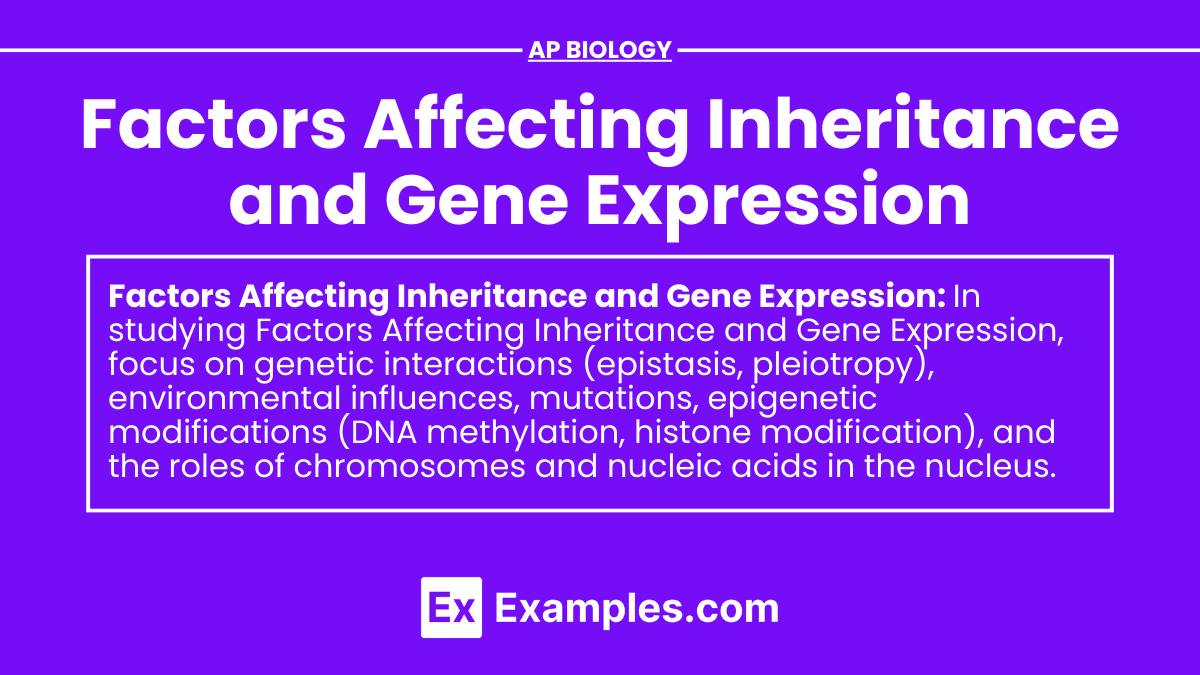Factors Affecting Inheritance and Gene Expression, a key topic in AP Biology, involve complex interactions within the nucleus where DNA and RNA play critical roles in determining an organism's genotype. These factors include genetic interactions, environmental influences, and epigenetic modifications, all contributing to the diversity of traits and how they are expressed. Understanding these influences is essential for comprehending the full complexity of genetic inheritance and gene regulation.
Learning Objectives
By studying Factors Affecting Inheritance and Gene Expression, you will understand how chromosomes and nucleic acids within the nucleus contribute to genetic diversity. You will explore the impact of mutations and environmental factors on gene expression. You will learn about epigenetic modifications, genetic interactions, and the mechanisms by which genes are regulated, giving you a comprehensive understanding of inheritance beyond Mendelian genetics.
Overview
Gene expression and inheritance are not solely governed by Mendelian genetics. Multiple internal and external factors, including environmental influences, genetic interactions, and epigenetic modifications, play significant roles.
Internal Factors
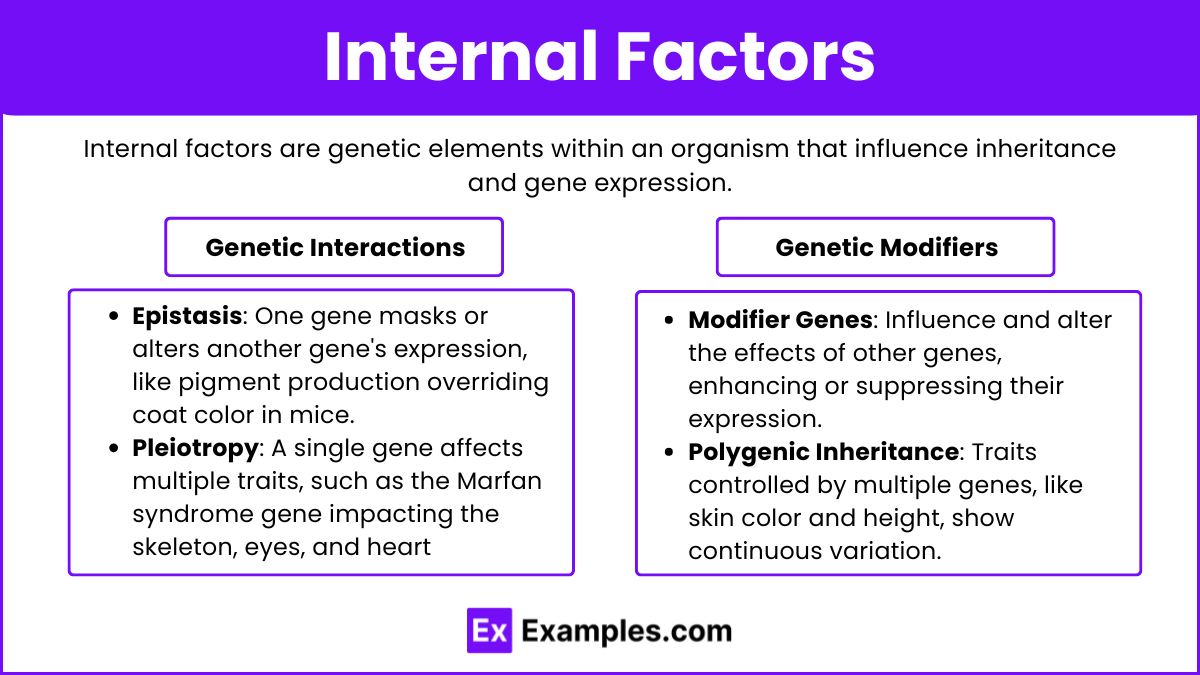
Genetic Interactions
Epistasis: One gene can mask or alter the expression of another gene. For example, in mice, the gene for coat color can be overridden by a gene that controls pigment production.
Pleiotropy: A single gene can affect multiple traits. For instance, the Marfan syndrome gene impacts connective tissue, affecting the skeleton, eyes, and cardiovascular system.
Genetic Modifiers
Modifier Genes: These genes influence the expression of other genes. They can enhance, suppress, or alter the effects of other genes.
Polygenic Inheritance: Traits controlled by multiple genes, such as skin color and height, show continuous variation within a population.
External Factors

Environmental Influences
Temperature: The temperature can affect the expression of certain genes. For example, the fur color in Himalayan rabbits is influenced by temperature, with cooler areas of the body developing darker fur.
Nutrition: Nutrient availability can impact gene expression and phenotypic traits. Poor nutrition during critical growth periods can alter growth patterns and development.
Chemical Exposure
Drugs and Toxins: Exposure to chemicals can modify gene expression and result in phenotypic changes. For example, exposure to teratogens during pregnancy can lead to congenital disabilities.
Epigenetic Factors
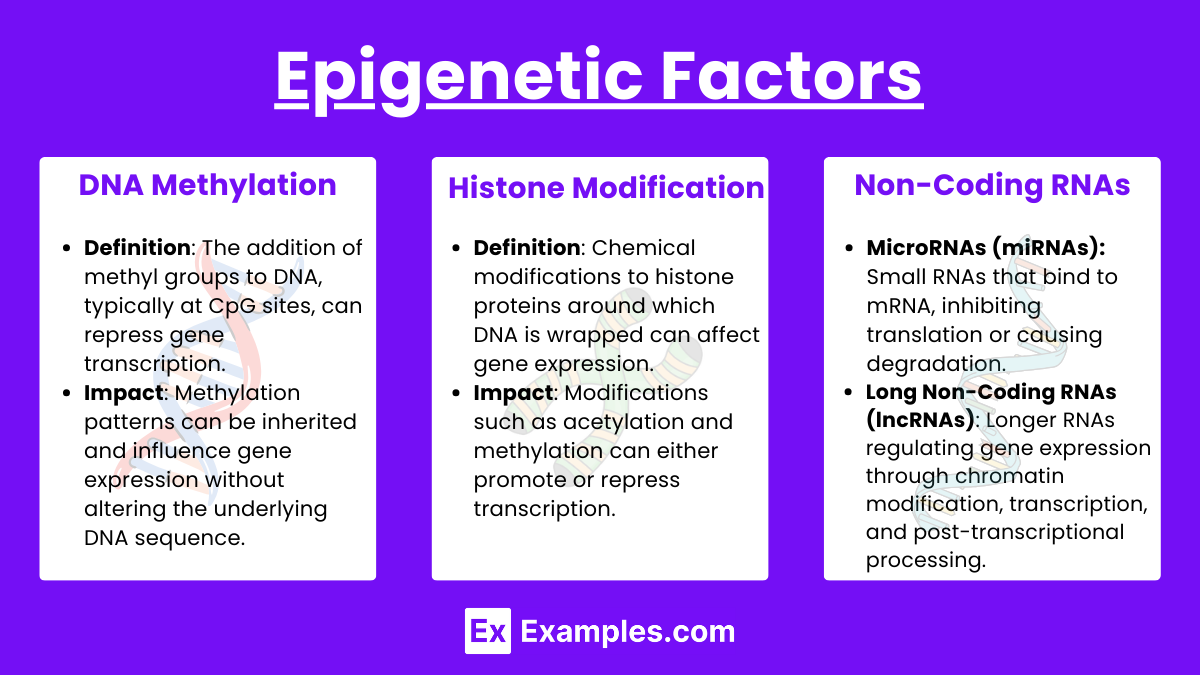
DNA Methylation
Definition: The addition of methyl groups to DNA, typically at CpG sites, can repress gene transcription.
Impact: Methylation patterns can be inherited and influence gene expression without altering the underlying DNA sequence.
Histone Modification
Definition: Chemical modifications to histone proteins around which DNA is wrapped can affect gene expression.
Impact: Modifications such as acetylation and methylation can either promote or repress transcription.
Non-Coding RNAs
MicroRNAs (miRNAs): Small RNA molecules that can bind to mRNA and inhibit translation or lead to mRNA degradation.
Long Non-Coding RNAs (lncRNAs): Longer RNA molecules that can regulate gene expression at various levels, including chromatin modification, transcription, and post-transcriptional processing.
Regulatory Mechanisms
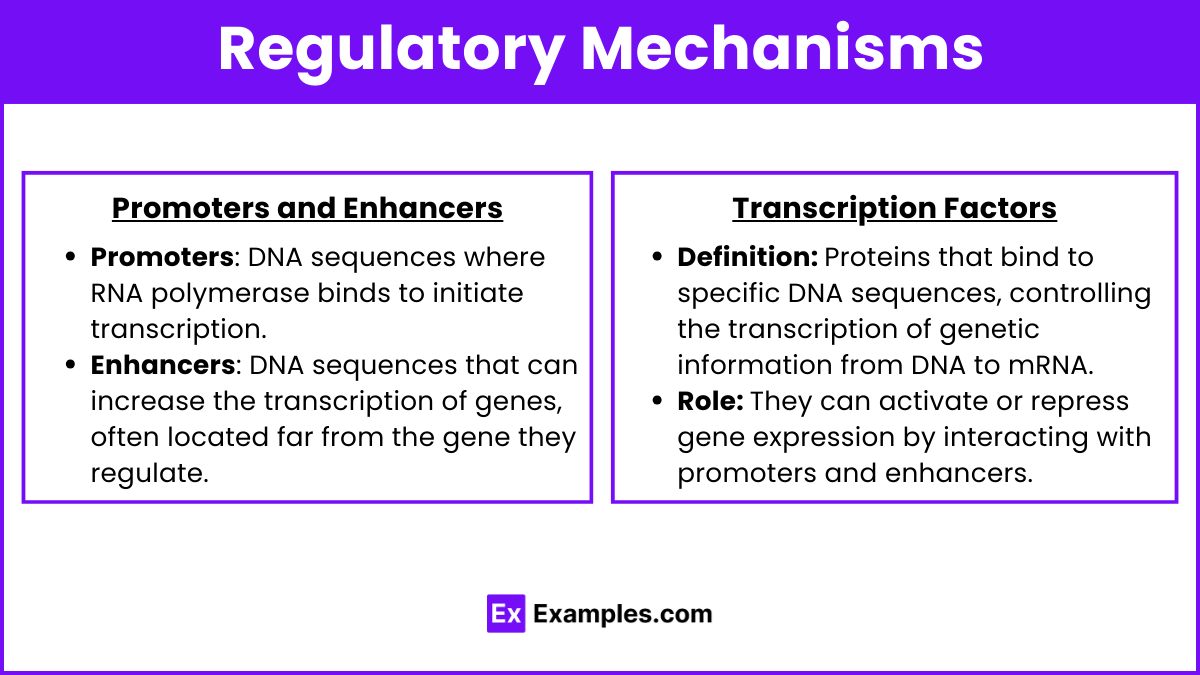
Promoters and Enhancers
Promoters: DNA sequences where RNA polymerase binds to initiate transcription.
Enhancers: DNA sequences that can increase the transcription of genes, often located far from the gene they regulate.
Transcription Factors
Definition: Proteins that bind to specific DNA sequences, controlling the transcription of genetic information from DNA to mRNA.
Role: They can activate or repress gene expression by interacting with promoters and enhancers.
Genetic Imprinting
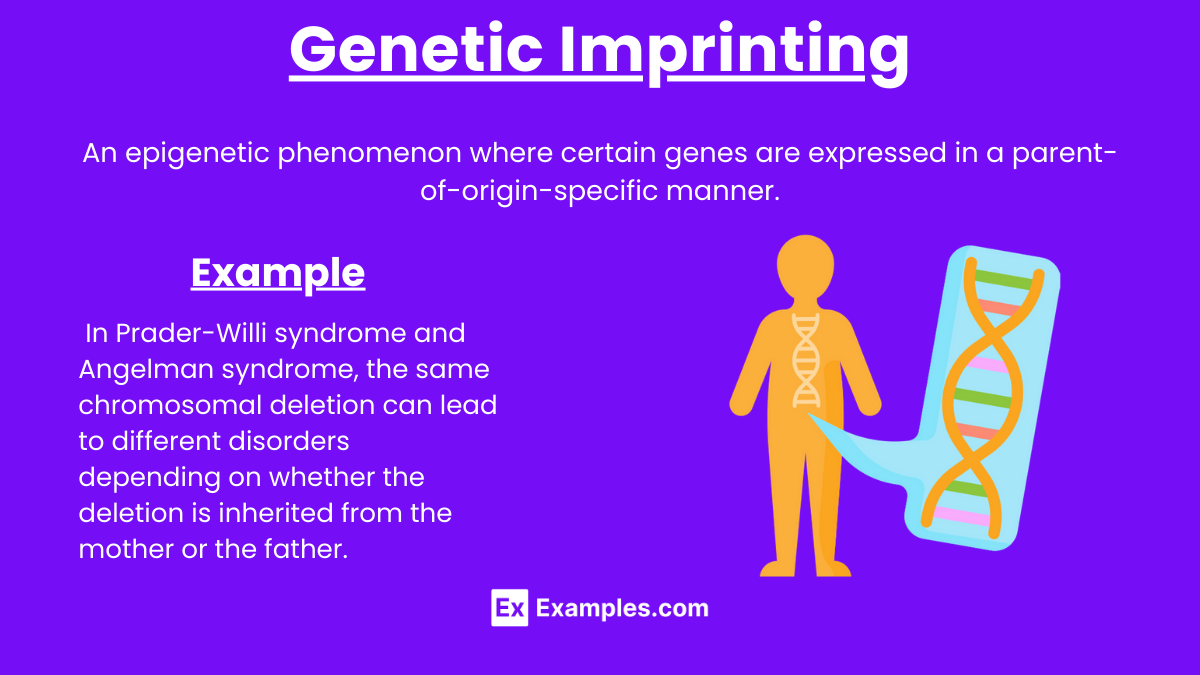
Definition: An epigenetic phenomenon where certain genes are expressed in a parent-of-origin-specific manner.
Example: In Prader-Willi syndrome and Angelman syndrome, the same chromosomal deletion can lead to different disorders depending on whether the deletion is inherited from the mother or the father.
Examples
Example 1: Epistasis
Scenario: In Labrador retrievers, coat color is determined by two genes.
Genetic Factors: One gene determines pigment color (B for black, b for brown), and another gene determines pigment deposition (E for pigment deposition, e for no deposition).
Phenotype: Dogs with the ee genotype are yellow, regardless of the B/b alleles.
Example 2: Polygenic Inheritance
Scenario: Human skin color is influenced by multiple genes.
Genetic Factors: Several genes contribute to melanin production.
Phenotype: The interaction of these genes results in a continuous range of skin colors.
Example 3: X-Linked Traits
Scenario: Red-green color blindness.
Genetic Factors: The gene responsible is located on the X chromosome.
Phenotype: Males (XY) are more likely to be colorblind if they inherit the mutant allele from their mother, whereas females (XX) must inherit the mutant allele from both parents to be colorblind.
Example 4: Temperature-Dependent Gene Expression
Scenario: Fur color in Himalayan rabbits.
Environmental Factors: Temperature affects enzyme activity responsible for pigment production.
Phenotype: Rabbits have dark fur on cooler parts of their bodies (ears, nose, feet) and lighter fur on warmer parts.
Example 5: DNA Methylation and Gene Expression
Scenario: X-chromosome inactivation in female mammals.
Epigenetic Factors: Methylation silences one of the X chromosomes in each cell.
Phenotype: Dosage compensation ensures females (XX) do not have double the gene expression of X-linked genes compared to males (XY).
Practice Questions and Answers
Question 1
How can epistasis affect the phenotypic ratios observed in genetic crosses?
A. By causing mutations in the gene sequences
B. By changing the environment of the organism
C. By influencing the expression of one gene by another gene
D. By increasing the number of alleles for a trait
Answer: C. By influencing the expression of one gene by another gene
Explanation: Epistasis occurs when the expression of one gene is influenced by another gene. This can alter the expected phenotypic ratios from Mendelian inheritance. For example, in Labrador retrievers, the gene for pigment deposition (E/e) can mask the expression of the gene for pigment color (B/b). Dogs with the ee genotype will be yellow, regardless of the B/b alleles. Thus, a cross between two BbEe dogs will produce a modified 9:3:3:1 ratio, resulting in 9 black, 3 brown, and 4 yellow puppies.
Question 2
How can environmental factors influence gene expression, using temperature-dependent fur color as an example?
A. By altering the DNA sequence
B. By changing the number of chromosomes
C. By affecting enzyme activity or protein stability
D. By increasing the rate of cell division
Answer: C. By affecting enzyme activity or protein stability
Explanation: Environmental factors such as temperature can influence gene expression by affecting enzyme activity or the stability of proteins. In Himalayan rabbits, the gene responsible for fur color produces an enzyme that is active only at cooler temperatures. This results in dark fur on the cooler parts of the body (ears, nose, feet) and lighter fur on the warmer parts. This demonstrates how external conditions can affect the phenotype by modulating gene expression.
Question 3
How does X-linked inheritance differ from autosomal inheritance?
A. X-linked inheritance involves genes on the Y chromosome
B. X-linked inheritance affects only females
C. X-linked inheritance involves genes located on the X chromosome and shows different patterns compared to autosomal inheritance
D. X-linked inheritance requires two copies of the allele for males to express the trait
Answer: C. X-linked inheritance involves genes located on the X chromosome and shows different patterns compared to autosomal inheritance
Explanation: X-linked inheritance involves genes located on the X chromosome and exhibits different patterns compared to autosomal inheritance. Since males have only one X chromosome (XY), a single recessive allele on the X chromosome can cause the trait to be expressed. In contrast, females (XX) need two copies of the recessive allele to express the trait. An example is red-green color blindness, which is more common in males. A male needs only one copy of the mutant allele from his mother to be colorblind, while a female must inherit the mutant allele from both parents.

